Over the last couple of years, Gun Tests has reviewed several 10mm pistols, most recently in the November 2021 issue, and prior to that, in September 2020, August 2020, March 2019, November 2017, May 2017, and others that you can find by searching for “10mm” in the online index. Impressed by most of what we have seen, some testers have switched to a 10 mil for our backup guns when out in the boonies. Springfield Armory and Smith & Wesson recently added two more of these 40-caliber thumpers to the mix, so we looked at them side by side. Tested: A Springfield Armory XD-M Elite 3.8-inch Black Comp with OSP XDME93810CBOSP and a Smith & Wesson M&P 2.0 10mm.
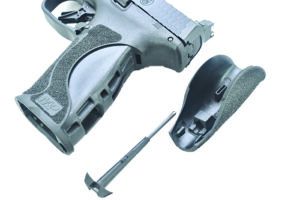
Many shooters mourned the passing of the 10mm Auto as a commercially viable cartridge back in the 1990s. Time has proven those concerns to have been premature. Once only a niche cartridge, the 10mm Auto has exploded back onto the shooting scene in the last 10 years or so. The power of the 10mm, which has been seen by some as a negative, now attracts outdoor enthusiasts who carry a pistol for backup and hunting in areas where they are not at the top of the food chain.
We recognize that some of the stories about recoil on the 10 mil may have been exaggerated. We also agree that the 10mm will recoil more than an average 45 ACP, and it can be a factor to some. That being the case, the specs on these two new pistols caught our attention. Both of these pistols are compacts designed to be even more easily carried afield.
How We Tested
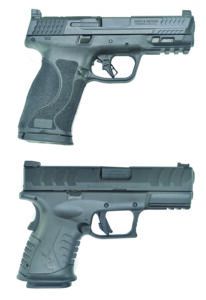
The Springfield Armory unit that we tested is officially an XDME 3.8-inch Black Comp Elite with OSP XDME93810CBOSP, recently listed for $575 at BudsGunShop.com. The Smith & Wesson M&P 2.0 10mm sold for $619 at GunDeals.com. We fired them head to head at American Shooting Centers in west Houston. Due to their compact dimensions, we fired them for accuracy at 15 yards by shooting multiple five-shot groups from a well-sandbagged Caldwell Pistolero shooting rest and a Mini DRC Fortune Cookie from Wiebad.com. We measured velocities via a LabRadar chronograph using three different types of ammunition, mixing it up between JHP and defensive loadings. The first selection was 180-grain jacketed hollow points (JHP) from Magtech. Next was a different 180 JHP from Sellier & Bellot. Then we added the HSM 200-grain round-nosed flat-point “Bear Load.”
Basic physics being what they are, the smaller and lighter the handgun, the snappier the recoil. What did we find with the two new offerings? Was recoil substantially greater? How well could we hold onto the shorter grips? Did the shorter barrels lose too much accuracy or velocity? Let’s find out.
Gun Tests Grade: A (OUR PICK)
$619
The Smith & Wesson M&P 2.0 was, slightly, the more accurate of the two 10mms tested. Though a very subjective thing, we felt the S&W had the lighter recoil impulse, and the shooting results testified to that. We also needed a shooting glove to burn through a couple of hundred rounds for this pistol, and we feel the grips would benefit from the light touch of some 600-grit sandpaper.
| Action Type | Semi-auto, striker fired |
| Overall Length | 7.2 in. |
| Overall Height | 5.5 in. |
| Maximum Width | 1.43 in. |
| Weight Unloaded | 1.5 lbs. |
| Weight Loaded | 2.3 lbs. with 16 rounds |
| Slide Material | Stainless steel w/Armornite finish |
| Slide Retraction Effort | 15.3 lbs. |
| Receiver Material | Polymer |
| Finish | Black |
| Front Strap Height | 2.5 in. |
| Back Strap Height | 3.8 in. |
| Barrel Length | 4.0 in. |
| Grip Thickness (Maximum) | 1.2 in. |
| Grip Circumference | 5.5 in. using small grip insert |
| Magazine | Two 15 round |
| Rear Sight | Drift adjustable, optics co-witness height |
| Front Sight | Drift adjustable, optics co-witness height |
| Sight Radius | 6.4 in. |
| Trigger Pull Weight | 4.6 lbs. |
| Trigger Span | 3.0 in. |
| Safety | Striker, trigger |
| Warranty | Lifetime service policy |
| Telephone | (800) 331-0852 |
| Website | Smith-Wesson.com |
| Made In | USA |
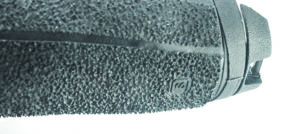
The Smith & Wesson M&P 2.0 was introduced late in 2021, including the 10mm version. As part of the group who likes the 10 mil, we were pleased that a 40-bore offering was included near the initial launch of the revised platform instead of as something of an afterthought. One of the things we really appreciated is the effort S&W has made to ensure that the company’s optic-ready platforms will work for as many of the available red dot optics as possible. Unlike standardized mounting systems, such as the Picatinny rail, many handguns seem to require something much more like rifle scope mounts and rings, which necessitate a different product for each different model. We think that the required polyglot of mounts needlessly complicates the transition to and installation of some very beneficial sights. Smith & Wesson helped mitigate the issue by including no less than seven different mounting plates and a variety of screws with the pistol. Thank you.
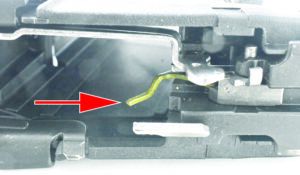
In fact, much like the Springfield, the S&W M2.0 can be ordered in any number of configurations. We obtained a model with cuts (and cover plate) for various red-dot sights. Ours also includes optical-sight-height iron sights, allowing the shooter to co-witness through the red-dot window. We also wanted a model without a manual thumb safety. Manual safety models are available as well. Those iron sights are about a half-inch tall and provide a very good sight picture. Front and back are both black, drift adjustable and have three white dots — two on the rear and a single one on the front — which are not our favorites. We like the fiber-optic front and black rear, but that is just personal preference. For those in our camp, a little bit of black paint solves your problem. The cover for the optical sights has been lightly stippled to a matte-black finish, providing a section of non-reflective metal right in front of the rear sight.
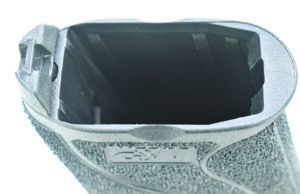
The slide is stainless steel with an Armornite finish, leaving the top end with a well-protected matte-black look. The grasping grooves, both fore and aft, were cut using a distinctive pattern of curved lines. Once again, these are sharp enough to grab your hand without cutting them up. The 4-inch barrel has a notch cut in the rear of the barrel hood that serves for visual chamber checks. The magazine release arrived installed on the left side for right-handed shooters. It can be reversed as desired. The slide lock is ambidextrous, and we noticed an update there. We have a couple of older versions of the M&P where, when a replacement magazine is inserted enthusiastically, the slide stop can bounce out of its notch, allowing the slide to go back forward. We have never seen that be a problem, but it can be disconcerting for some. On the new M&P 2.0, we found fixtures on both slide stops we believe are designed to prevent just that.
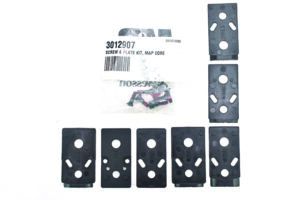
As with the Springfield XD-M Elite, we found an updated trigger design. The shoe of the trigger is almost flat and is set to break at a vertical position. The safety blade has been changed, bringing a wider engagement surface. Then S&W added a tab on the surface of the frame that serves as an overtravel stop. The result is a fairly crisp pressure wall that breaks cleanly with about 1⁄8-inch travel (maybe a hair more) afterward.
The polymer frame has a long enough dust cover to allow for a three-slot Pic rail. S&W includes four different palm inserts (small, medium, medium-large, and large) that are easily changed by rotating and removing a base pin from the bottom of the grip frame. The very bottom of the grip frame has two scallops located to allow a good grip of the magazine, should said mag prove resistant to removal. Two 15-round mags are included. Ten-rounders are available where needed. We frequently complain about slick-surfaced pistols (except for those which spend their life right next to our skin), but the M&P 2.0 is definitely not slick. The grip surface is well-stippled to the point where we thought it might be a tad too sharp. Too sharp, however, is a whole lot easier to fix than too smooth. A light pass or two with some 600-grit sandpaper might be just the ticket. We used an old pair of Uncle Mike’s shooting gloves that really helped with the stippling and the recoil.
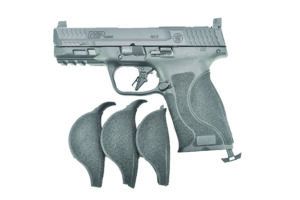
The M&P shot five-shot groups that average 1.6 inch, showing a preference for the Sellier & Bellot 180-grain loads (1.46 inch overall with a best five-shot group of 1.1 inch). We surmise that the slightly longer grip helped us hold onto it better than the somewhat more concealable XD-M Elite because the shooting results showed the advantage going to the S&W. For five shots from the low ready at 7 yards, the XD-M Elite averaged splits of 0.47 seconds and total time of 2.81 seconds. The S&W came in with 0.41 splits and 2.66 seconds total time. On the five shots at 5 yards at 5-inch circles, the Springfield averaged 0.466-second splits and 2.93 seconds total times, with the S&W coming in at just under 0.40-second splits and 2.62 seconds total time — all of these using full-house loads from concealable 10mms.
Our Team Said: We were pleased with the performance of both pistols, giving both the same grade, but giving a slight edge to the M&P and making it Our Pick.
Drill Data (5x5x5)
Process: Fire five shots from low ready at a 5-inch circle placed at 5 yards. Numbers are averages for two repetitions.| Pistol | Time to First Shot (seconds) | Split Average | Total Time |
|---|---|---|---|
| Springfield Armory XD-M Elite | 1.07 | 0.47 | 2.93 |
| Smith & Wesson M&P 2.0 | 1.04 | 0.4 | 2.62 |
Drill Data (5x7)
Process: Fire five shots from low ready at a 8-inch circle placed at 7 yards. Numbers are averages for three repetitions.| Pistol | Time to First Shot (seconds) | Split Average (seconds) | Total Time (seconds) |
|---|---|---|---|
| Springfield Armory XD-M Elite | 1.02 | 0.45 | 2.81 |
| Smith & Wesson M&P 2.0 | 1.03 | 0.41 | 2.66 |
10mm Auto Range Data
We tested at American Shooting Centers in Houston. We used a LabRadar chronograph ($559) to measure muzzle velocities. We fired five-round groups from a well-sandbagged Caldwell Pistol Rest from MidwayUSA.com and aided by a mini-DRC Fortune Cookie bag from Wiebad.com. Distance: 15 yards.
| Magtech 180-grain JHP | Springfield XD-M Elite | Smith & Wesson M&P 2.0 |
| Average Velocity | 1152 fps | 1141 fps |
| Muzzle Energy | 530 ft.-lbs. | 521 ft.-lbs. |
| Average Group | 2.85 in. | 1.73 in. |
| Best Group | 2.62 in. | 1.34 in. |
| Sellier & Bellot 180-grain JHP | Springfield XD-M Elite | Smith & Wesson M&P 2.0 |
| Average Velocity | 1061 fps | 1054 fps |
| Muzzle Energy | 450 ft.-lbs. | 444 ft.-lbs. |
| Average Group | 1.78 in. | 1.46 in. |
| Best Group | 1.39 in. | 1.10 in. |
| HSM 200-grain Hard Cast | Springfield XD-M Elite | Smith & Wesson M&P 2.0 |
| Average Velocity | 1057 fps | 1071 fps |
| Muzzle Energy | 496 ft.-lbs. | 510 ft.-lbs. |
| Average Group | 1.7 in. | 1.62 in. |
| Best Group | 1.3 in. | 1.19 in. |




























I want to see a comparison between the S&W and the SIG 320 10mm guns.
I still love my Glock 20!!
I still love my glock 20 and 29!
Agreed!